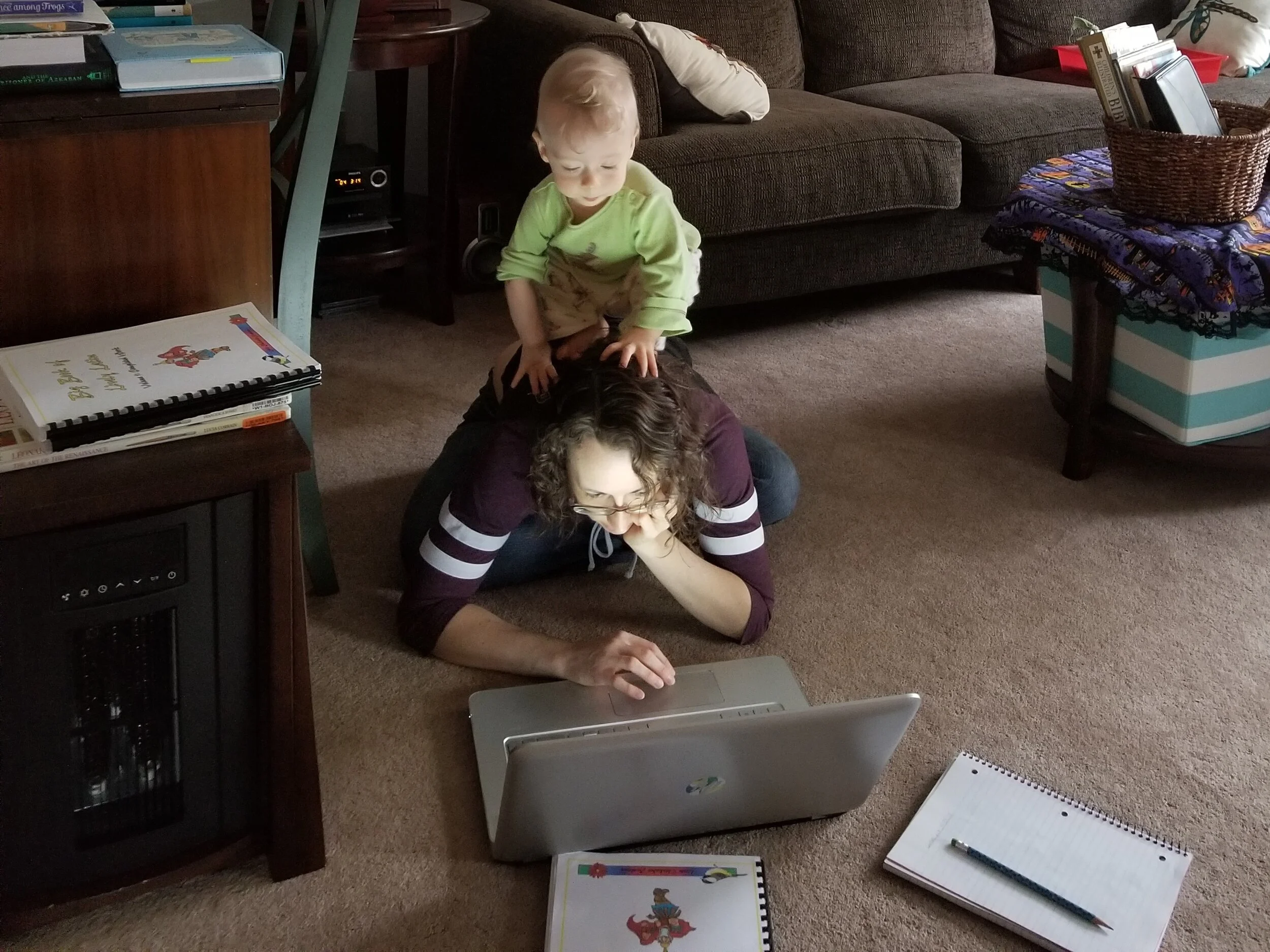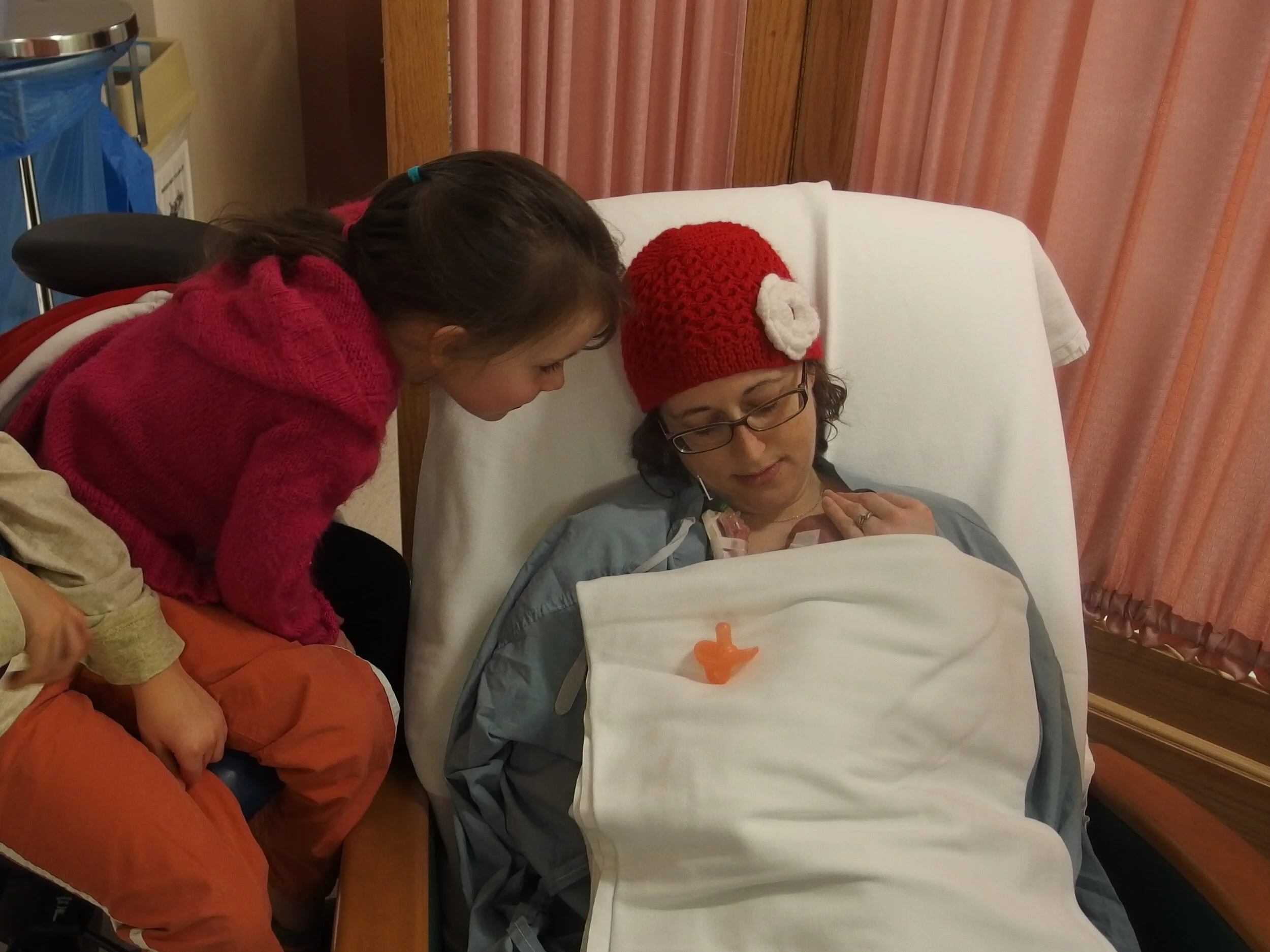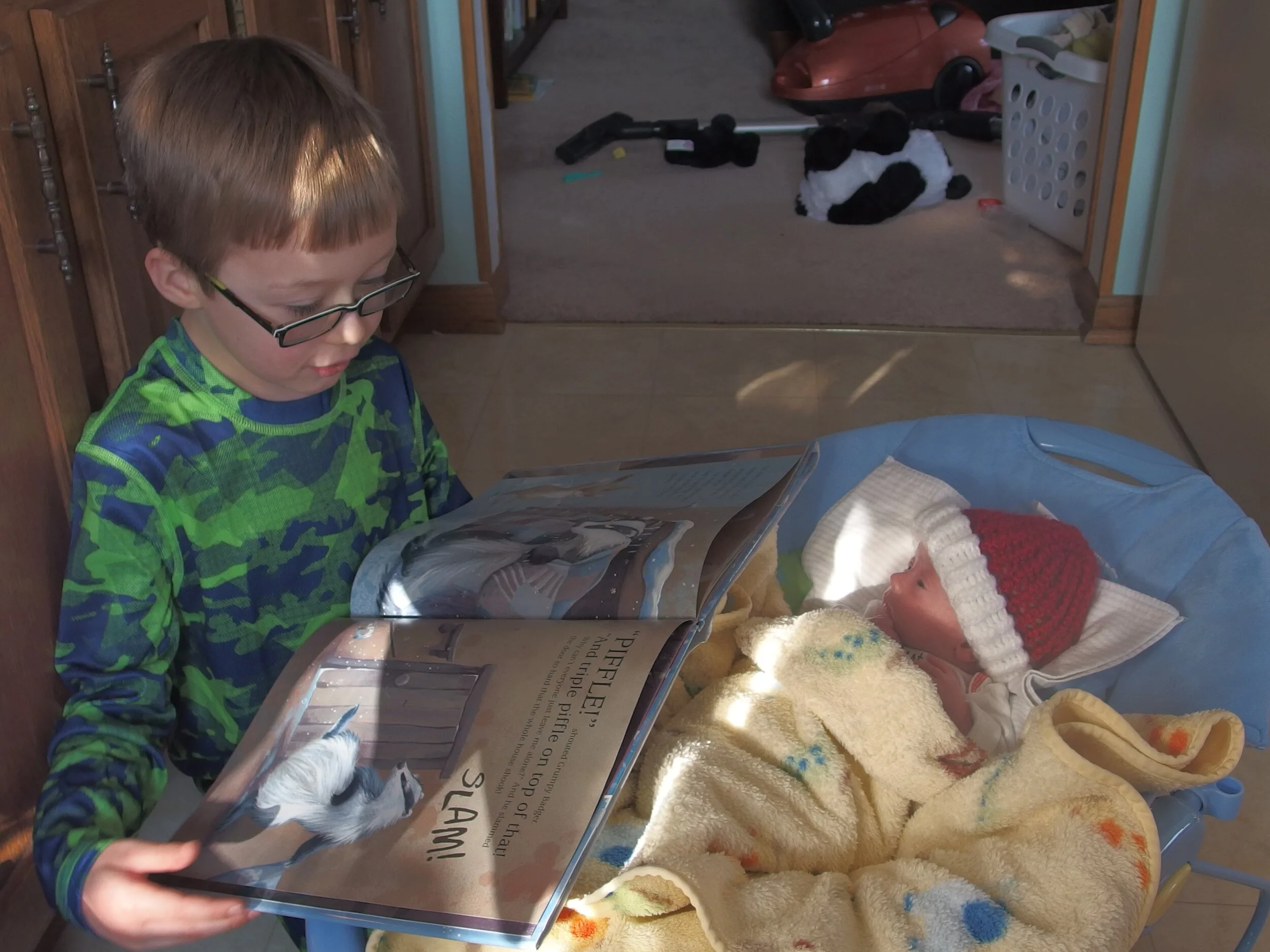Homeschooling with a Toddler in the House
A challenge many homeschooling parents face at some point in their journey is how to homeschool older children when you are still grappling with a baby or a toddler in the house. As I was going through some pictures today, I came across this gem.
This picture fully captures what it has been like to work on lesson plans, homeschool two children, or try to do…well, ANYTHING, since my youngest child was born. This child, despite being born premature and being incredibly small for his age, was an early crawler and an insatiable climber. He could climb on furniture, and multi-level step stools, before he could walk. If he could walk, he had to run, and if he could climb on stable furniture, why not his mother’s unstable back? If you’re wondering if he went to a standing position after this picture was taken, why yes, yes he did.
From the moment he was born, he caused some pretty major disruptions to our homeschooling routine. First, he was born premature and spent five weeks in a Neonatal Intensive Care Unit. This was at the beginning of winter, so we were fully engrossed in homeschooling. Of course, we expected some disruptions given that we knew he would be entering our lives that winter. We even expected he might arrive early, as our daughter was also born premature, but we weren’t really ready for just how early and how small he would be. He arrived nearly eight weeks early and was growth restricted (only two pounds), which is not uncommon when a mother has preeclampsia (which I did). How did we survive? At first, our whole family stayed at a Ronald McDonald House and my mother came to help out with the kids when my husband had to go back home to spend some time at his job. We were very grateful that the Ronald McDonald House let us have two rooms so our older children could stay there with us. My mother would read books with the kids, do crafts with them, and play with them while I would spend time at the NICU. In the evening, I would spend time reading The Chronicles of Narnia to them. We did bring some homeschooling materials with us, so my mother would oversee some of their work during the day. When my husband was staying with us at the Ronald McDonald House, he would take charge of the kids while Gramma went home for a few days. In addition to keeping the kids engaged with books, activities, and assignments, he would make sure the kids got some time to take walks outside with him. During our first week in the NICU, our older children also got to come to the hospital to visit their baby brother. Given the timing of his birth, the NICU was closed to children soon after our arrival to protect the babies from seasonal influenza. My children were heartbroken that they couldn’t go visit their baby brother anymore, but we all understood that it was important to protect every baby in the NICU.
It’s a good thing the NICU instituted the policy of no child visitors, as our system unraveled quickly when a family staying at the Ronald McDonald House let in a large number of visitors through a back entrance instead of following the policies of the establishment, which required that all visitors enter through the front door and be screened in the front office. One of the unscreened visitors was a child who clearly had cold symptoms, and a few days later our daughter had a cold, despite our commitment to keep our children out of public spaces. My husband had to pack up and take the kids home. At the same time, my mother had gone home for a few days and was exposed to germs in her house; she couldn’t come back to help me. I was on my own, recovering from a c-section and preeclampsia, with mastitis, and devastated to be separated from my husband and kids for the last week of our new baby’s stay in the NICU. I spent nearly every waking minute at the NICU, and I don’t know how I would have gotten through that week without the support of two very special nurses and a wonderfully patient new mom who was staying at the Ronald McDonald House, as her son was also born premature (much earlier even than my little boy).
After my kids returned home, they accompanied my husband when he went to work each day and spent time in an unused office working on homeschooling materials, coloring pictures, reading a plethora of books, and engaging in a lot of quiet, self-entertainment. They did a really great job and impressed everyone at my husband’s office. Did they learn as much during this time? They learned a LOT, but it wasn’t very focused on traditional subjects. I would argue that some of the life lessons they learned during that time were invaluable, even it it meant a departure from the regular routine. What does this illustrate for others who are homeschooling during challenging times? First, it can be done, with some adjustments. Second, children are learning all of the time, and if you deviate from the normal path of learning, they will still keep learning. If you want them to learn something valuable (instead of the lyrics to every cartoon theme song and lots of commerical jingles), I would suggest you surround them with good books to read and choose some engaging programs that are fairly self-directed if you know you won’t be able to devote a lot of your day to lessons. For some period of time, they can accomplish a fair amount with limited parental involvement. I’m not suggesting that they will do everything without help, but some self-directed learning is possible while parents are otherwise occupied. This may not be a recipe for success for long-term learning for all children, but you can always get back on track later after a crisis has abated. Some homeschooling parents will tell you that the majority of their child’s education was self-directed. This approach to homeschooling is often referred to as unschooling. There I go again, talking about educational philosophies that I haven’t explained yet. I really will explain them soon on my questions page!
Okay, so after five weeks in the NICU, we brought home our new little guy (who was almost four whole pounds now), and everything went back to normal and our routine was restored! …yeah, not so much. This little guy was feeling very deprived of human snuggles after spending so much time in an isolette, and he was pretty much attached to his mommy all of the time. He wouldn’t stay asleep if he wasn’t being held. Given that I didn’t want him to expend energy for anything other than growth (did I mention he wasn’t even four pounds yet?), I admit I indulged him. He got to sleep on my chest and we learned to adapt our homeschooling routine. It actually went pretty well. The older kids would bring materials to where I was sitting while the baby napped, and we would read and do lessons while I fed him and held him. That worked out pretty well, until he started moving around.
Look out world! This little guy was into everything! Again, we adapted. When he napped, I would do lessons for subjects that I could cover with both of the kids at the same time (this works great for history, science, and literature). For subjects like math, spelling, and grammar, I would do lessons individually with each of the older kids. While I worked with one kid, the other one had baby duty. It was great for their relationship with the baby. They would keep him entertained, and the baby developed a close relationship with each of his siblings.
As our little guy got older, we continued to take turns entertaining him, and he developed a bit more independence, too. He has never been superb at self-entertainment and prefers that one of his older siblings play with him, but he will spend time building with Legos and Duplos and telling stories with action figures. That has made our schedule a little easier. Over time, we’ve included him in more lessons, too. He likes participating in science experiments and art projects, and he will sit and listen to stories for hours. His love for stories made him eager to learn how to read, so I started working on beginner books with him when he was barely four. He advanced so quickly that he can now read just about any children’s book that he wants! Kids who are really engaged in obtaining a new skill can learn at an incredible speed.
Did every day go well? Nope. But that’s just part of life. Some days we got a lot done, and some days we all ended up a bit frustrated. As with any family, we needed to adapt to changing circumstances along the way. In January, our daring youngest child fell as he was being playfully chased through our living room by his older brother. We didn’t think it was that bad of a fall, and his leg only had a small bump; his continued agonizing pain indicated that something was really wrong with his leg. It was broken. The poor little guy had his entire leg in a cast until May. We adapted to that, too. It turned out that children with broken legs who can’t run around and climb all over furniture can sit really nicely and learn how to read. (Eventually they learn how to climb even with a fully-casted leg and they start to make up for lost time, making their parents very nervous in the process!)
As I look ahead to the next year and try to figure out how I’m going to homeschool three kids with disparate ages and skills, it gives me a little comfort to reminisce about the previous four years. If we were able to meet the challenges we faced during the toddler years, then we can face the challenges of the upcoming year, too.





